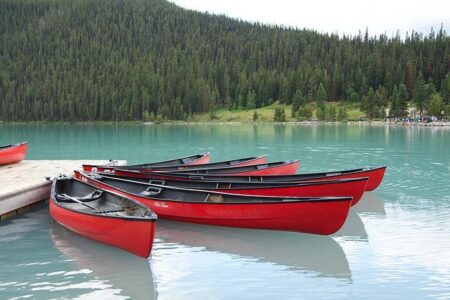Forillon National Park, managed by Parks Canada, stands as a breathtaking testament to Canada’s commitment to preserving its natural heritage. Situated at the eastern tip of the GaspĂ© Peninsula in Quebec, this expansive park offers visitors a unique blend of rugged coastal landscapes, diverse wildlife, and rich cultural history. As one of the country’s most cherished protected areas, Forillon continues to draw nature enthusiasts, hikers, and history buffs alike, highlighting the ongoing efforts of Parks Canada to balance conservation with public access. This article explores the park’s features, recent developments, and its significance within the broader context of Canadian national parks.
Exploring Forillon National Park’s Unique Coastal Ecosystems
Nestled at the eastern tip of the Gaspé Peninsula, Forillon offers a vibrant tapestry of coastal ecosystems where cliffs, beaches, and tidal pools converge. These diverse habitats support an impressive array of flora and fauna, with species uniquely adapted to the often harsh maritime climate. Visitors can witness rare wildflowers clinging to rocky ledges and seabirds like puffins and gannets nesting in dramatic cliffside colonies. Along winding boardwalks and rugged trails, naturalists and photographers alike find ample opportunities to capture the raw power of the Atlantic Ocean meeting rich biodiversity.
The park’s ecological richness is further emphasized by its dynamic marine environments. Intertidal zones teem with life ranging from vibrant seaweeds to crustaceans and mollusks, all crucial to sustaining local food webs. Key coastal features include:
- Salt marshes: vital breeding grounds for numerous bird species
- Sea caves: natural shelters formed by centuries of wave action
- Fjord-influenced bays: unique microhabitats harboring specialized marine life
Exploration here isn’t just scenic-it’s a dive into complex ecological interactions shaped by geological history and oceanic forces.
| Coastal Feature | Dominant Species | Ecological Role |
|---|---|---|
| Cliff Edges | Atlantic Puffin | Breeding habitat, nesting |
| Salt Marshes | Spartina Grasses | Erosion control, nursery grounds |
| Tidal Pools | Green Crabs | Predator-prey balance |
Wildlife Watching Tips for Forillon Visitors
Observing Forillon’s diverse fauna requires patience and respect for their natural habitats. Early mornings and late afternoons are prime times to spot moose, foxes, and seabirds, as wildlife is more active during these cooler hours. Carry binoculars and a camera with a zoom lens to capture moments without disturbing the animals. Stay on designated trails and maintain a safe distance; close encounters can stress wildlife and jeopardize your safety. Remember that sudden movements or loud noises can scare animals away, so move slowly and speak softly. Using scent-free insect repellent also helps you stay comfortable while minimizing your impact on local ecosystems.
When planning your visit, equip yourself with knowledge on animal behavior to enhance your experience. Here are some essential tips to keep in mind:
- Never feed wildlife – it disrupts natural foraging habits and can lead to dangerous situations.
- Respect nesting areas especially for migratory birds along the coastline.
- Use designated viewing platforms for optimal observation without habitat intrusion.
- Wear muted colors to blend into surroundings and avoid startling animals.
| Animal | Best Viewing Season | Preferred Habitat |
|---|---|---|
| Moose | Summer to Early Fall | Marshes and forest edges |
| Bald Eagle | Spring to Summer | Coastal cliffs and shorelines |
| Harlequin Duck | Year-round | Rocky shorelines and rapids |
| Red Fox | Late Summer to Fall | Open meadows and forest clearings |
Best Hiking Trails and Seasonal Activities at Forillon National Park
Forillon National Park offers an impressive variety of hiking trails that cater to all skill levels, from gentle coastal strolls to challenging uphill climbs. Among the most popular is the Les Graves Trail, where visitors can enjoy breathtaking panoramic views of the Gulf of St. Lawrence and the rugged cliffs below. For those seeking a more immersive experience, the Mountée des Origines Trail leads through dense forests and offers glimpses of local wildlife, including moose and migratory birds. Each trail is meticulously maintained, ensuring safe and scenic routes throughout the year.
Seasonal activities enhance the park’s appeal even further, creating engaging opportunities tailored to every visitor’s preferences. In spring and summer, guided kayak tours along the park’s coastline allow for intimate encounters with marine life, such as seals and various seabirds. Autumn invites hikers to witness the vibrant colors of the changing foliage on the Chute-Ă -la-Rouche trail, while winter transforms Forillon into a snowshoeing paradise with clear, marked paths. Here’s a quick overview of activities by season:
| Season | Popular Activities | Recommended Trail |
|---|---|---|
| Spring | Bird Watching, Kayaking | Les Graves Trail |
| Summer | Hiking, Guided Boat Tours | Mountée des Origines |
| Autumn | Foliage Viewing, Photography | Chute-Ă -la-Rouche |
| Winter | Snowshoeing, Cross-country Skiing | L’Anse-au-Griffon Loop |
Key Takeaways
Forillon National Park stands as a testament to Canada’s commitment to preserving natural beauty and cultural heritage. With its rugged coastlines, diverse wildlife, and rich history, the park continues to attract visitors seeking both adventure and tranquility. As Parks Canada maintains and safeguards this unique landscape, Forillon remains a must-visit destination for those looking to experience the wild heart of the GaspĂ© Peninsula.




